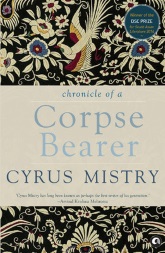Chronicles of a Corpse Bearer
Cyrus Mistry
|
In an elite and secluded part of India’s financial capital lives a small and segregated community of men whose job it is to trundle dead bodies for Parsi burial. Their story inspired “Chronicle of a Corpse Bearer”, the second novel from Indian writer Cyrus Mistry that recently won the DSC Prize for South Asian Literature. It documents the lives of the corpse bearers or khandhias, the “untouchables” of the Parsi community, Zoroastrians who emigrated from Persia to India more than a thousand years ago. The Parsis do not cremate or bury the dead — they rely on the khandhias to collect the bodies and perform the last rites before the corpses are left to decay or consumed by vultures at the Towers of Silence. Tucked away in a 54-acre expanse of lush forests atop Malabar Hill, one of South Mumbai’s most exclusive and scenic neighborhoods, the Towers of Silence and the khandhias who live there are almost entirely excluded from the outside world. Mr. Mistry, who is also a film director and was born into the Parsi community, said he only learned about the khandhias when he was commissioned to write a proposal about them for a Channel 4 documentary. The film was never made, but the story about a middle-class Parsi who defied societal norms and married the daughter of a khandhia inspired the characters for his novel. “Chronicles of a Corpse Bearer” tells the story of Phiroze Elchidana, the pampered son of a high priest, who falls in love with Sepideh, the daughter of a corpse bearer. Phiroze leaves behind the prestige of priesthood for the woman he loves, and agrees to take on the backbreaking and demeaning work of the khandhias. In a tragic twist, Sepideh is stung by a snake shortly after she marries Phiroze, and he is left to mourn her death while, on a daily basis, dealing with the grief of others who have lost their loved ones. The novel opens with him being woken abruptly from a dream about his wife in order to handle corpses that “have begun to stink.” The khandhias are the lowest caste of the Parsi community, seen as “sources of contamination who are forbidden from normal interactions with others,” explained Mr. Mistry. Khandhias must perform rituals of self-purification on a daily basis if they are to interact with others, but often do not venture out of their living quarters, which are in the same premises as the Towers of Silence, he added. “No one hears about the khandhias, it’s such a microscopic community within an already-small community… but it raises universal questions about life, love and death,” said the 57-year-old writer. Mr. Mistry pulls no punches as he describes the contagion and disease to which the khandhias expose themselves while handling dead bodies, and the way they are treated by other Parsis: “as dirt, the very embodiment of [excrement]… untouchable to the core.” The novel spans 60 years of Mumbai’s history, from the early 1940s to the turn of the 20th century. But it only rarely mentions political events, such as Mahatma Gandhi’s Quit India Movement, which were taking place away from the Towers of Silence, to emphasize how closed off the khandhia community is. The novel ends with the narrator expressing concern that a rapidly dwindling population of vultures has forced the Parsi community to search for new methods to handle the dead. “Solar receptors were installed at the Towers of Silence to help incinerate the bodies, but many orthodox Parsis don’t believe this is appropriate,” said Mr. Mistry. Mr. Mistry says he stopped practicing Zoroastrianism when he was 16, has married a Christian and has not raised his son to continue in the religious tradition. When Mr. Mistry learned he had won the prize, he said his first feeling was relief. “I’ll now be able to get back to writing my next novel full-time,” he said. “It felt really good to learn that it was a unanimous jury decision,” said the writer, adding that although he has received awards for some of his screenplays, the last time he won such a prestigious prize was for his play “Doongaji House” when he was 21. “My family is thrilled,” he said. Mr. Mistry is the second Indian to win the annual prize, now in its fourth edition. He received $50,000 in prize money and dedicated the award to his sister, Phiroza, whom he said has always believed in him. Shanoor Seervai |22 Jan 2014 | Wall Street Journal
|


 Cyrus Mistry
Cyrus Mistry